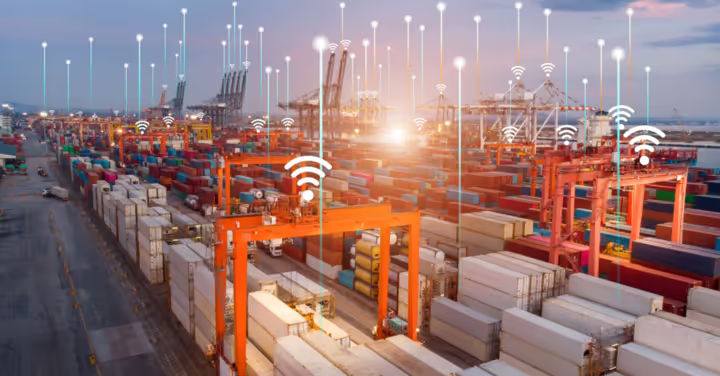After facing pandemic-era challenges, it’s clear that investment in technology is vital for shippers looking to navigate the volatile transportation industry. Shippers need visibility, and ports need the technology to not only support this but also to help improve port operations themselves. This is where smart ports are emerging. The global smart ports market is expected to increase to $16 billion by 2033, a 20.4% CAGR from 2023 to 2033. This growth underscores the increasing reliance on technology and the current digital transformation within the ocean freight sector. In this article, we’re diving into what smart ports will mean for shippers and their role in the future of global supply chains.
What is a Smart Port?
According to The Smart Port Alliance, smart ports “minimize the negative impacts of their activities on the natural environment and enhance the surrounding communities—economically and socially.” It’s also important to understand that there is not any single thing that is a requirement of a smart port. It’s simply to “achieve results without creating new challenges.” This may include some of the following.
Digitalization and Connectivity – A smart port might leverage digital technology, such as the Internet of Things (IoT), sensors, and data analytics, to gather and process real-time information from various sources—ships, containers, and supporting infrastructure—connecting the port ecosystem through advanced networks.
Intelligent Infrastructure – A smart port might implement intelligent infrastructure solutions to efficiently manage the movement of goods and vessels. This includes quay walls equipped with sensors to monitor their condition, smart buoys for real-time navigation information, and dynamic route planning systems.
Data-Driven Operations – A smart port might leverage big data and advanced analytics to optimize its operations. The port authorities can make informed decisions regarding vessel scheduling, cargo handling, and maintenance activities by collecting and analyzing vast amounts of data.
Predictive Maintenance – A smart port might employ predictive maintenance techniques using data analytics and machine learning algorithms. The port can predict maintenance needs, reduce downtime, and enhance operational efficiency by monitoring the condition of anything from cranes to bridges.
Energy Efficiency and Sustainability – A smart port might commit to reducing its environmental impact, implementing initiatives such as shore power facilities to supply electricity to ships at berths, using clean energy sources, and developing smart grids to optimize energy distribution.
Collaborative Platform – A smart port might establish a collaborative platform that connects various stakeholders, including shipping companies, terminal operators, customs authorities, and logistics providers. This type of platform enables seamless information exchange and simplifies the coordination of processes within the port.
What do Smart Ports Mean for Shippers?
Smart port technology offers numerous benefits for the port that also lead to benefits for shippers. This includes:
- Improved efficiency – Faster turnaround times at the port mean less wasted time and reduced costs for the shipper.
- Enhanced visibility – Real-time data helps shippers track shipments and adjust their supply chains accordingly.
- Improved safety and security – Sensors and cameras can help reduce the risk of accidents and incidents.
- More sustainable operations – With a commitment to sustainability, smart ports, in turn, help shippers with their own sustainability goals.
As Port Technology Advances, Shippers Bring Innovation In-House
To realize the full benefits of smart ports, shippers and freight forwarders must invest in their in-house technology. Smart ports run on data and visibility. Shippers need solutions that automatically take this data and extract valuable insights that they can use to drive action. In this way, smart port technology supported by tech-forward in-house strategies, shippers are equipped to better navigate volatility.
Here are three ways shippers can leverage the capabilities of smart ports to improve their operations.
Geofencing from Telematics
Telematics data plus geofencing capabilities allow shippers to establish virtual boundaries or geofences within the port area. Highly precise geofences, as provided by VIZION’s partner Kestrel Insights, can trigger real-time notifications or alerts when a vehicle or cargo enters or exits a specific zone. This precise location data empowers shippers to closely monitor and track the movement of their cargo within the port, enabling them to streamline operations and reduce costs.
Collaboration from Integration
With a wide range of visibility data available from different sources within the port, shippers can leverage a powerful integration platform like Chain.io, which VIZION has partnered with to better connect partners across supply chains. This integration acts as a central hub, transforming raw data into actionable intelligence and empowering shippers to improve their supply chains through greater collaboration.
Data Enrichment from Real-Time Visibility
For some shippers, the data provided by ports may not be detailed or specialized enough for their needs. With Vizion, shippers can get data enrichment add-ons, including enhanced locations, enhanced terminal visibility, vessel verification, customs data, live ETAs, and enhanced rail visibility. Shippers can home in on the data they need to ensure operations run smoothly and efficiently.
Get Smarter Visibility at Any Port with VIZION
VIZION doesn’t need smart port data to give shippers and BCOs advanced visibility data for smarter supply chains and more efficient port operations. VIZION API provides real-time container tracking and events, notifications, and insights to help improve port performance and, ultimately, reduce costs. To learn more about VIZION API, reach out to us to schedule a demo.



%20(11).png)
%20(9).png)
%20(7).png)














